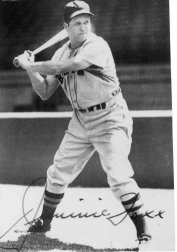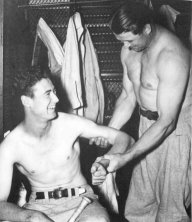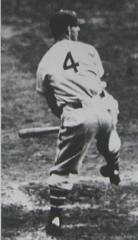
DOUBLE XX.
By John B Holway
 I first saw Jimmie Foxx on Memorial Day,
1940. Over 84,000 people, the
third-largest crowd in Yankee Stadium history at that time, were also on
hand. After ten years of Depression
– my entire life – I was about to see my first major league game,
the Yankees against the Red Sox. A
rich friend of my father had bought box seat tickets right over the Boston
dugout. The game was a few minutes
old when we hustled through the tunnel from under first-base
stands. Suddenly there, framed
in the tunnel exit not 100 feet away, his muscles bulging beneath his sleeves,
his cheek bulging with tobacco, brandishing his bat menacingly, crouched
Jimmie Foxx.
I first saw Jimmie Foxx on Memorial Day,
1940. Over 84,000 people, the
third-largest crowd in Yankee Stadium history at that time, were also on
hand. After ten years of Depression
– my entire life – I was about to see my first major league game,
the Yankees against the Red Sox. A
rich friend of my father had bought box seat tickets right over the Boston
dugout. The game was a few minutes
old when we hustled through the tunnel from under first-base
stands. Suddenly there, framed
in the tunnel exit not 100 feet away, his muscles bulging beneath his sleeves,
his cheek bulging with tobacco, brandishing his bat menacingly, crouched
Jimmie Foxx.
I could have fainted.
That winter he sent me this picture.
Who was Jimmie Foxx? In a
few weeks he would pass the dying Lou Gehrig and take over second place behind
Babe Ruth in lifetime home runs.
He would remain there for 25 years, until Willie Mays finally passed
him in 1965.
Yet how many fans today know who Jimmie
was? That includes the postmaster
general of the United States, who has just put out a set of four “great
slugger” stamps and left “Double X” off
completely.
In his greatest year, Foxx walloped 58
homers. It might have been 60
or 61, but he fell off a ladder at home and missed the last few games of
the season. He could blast
line drives over the roof of Philadelphia’s old Shibe Park (Connie Mack)
Stadium, and is the only man to conquer the centerfield wall there, 468 feet
from home. He’s also the only man to smash two homers over the roof
of Comiskey Park, both blows 500 feet, plus.
 Lefty Gomez of the Yankees knew him
well. Jimmie powered one of
Lefty’s pitches so deep into the third deck in Yankee Stadium that Gomez
said it took him 45 minutes to climb up to the spot after the
game. “Even his hair had
muscles,” Lefty winced. Next
time Double-X came up, Gomez just stood motionless on the mound until catcher
Bill Dickey jogged out to see what was
wrong. “Let’s wait
a few minutes,” Gomez said, “maybe he'll get a long-distance telephone
call.” When Lefty’s
doctor prescribed glasses, he got his first clear look at Foxx at
bat. The sight so shocked him that he threw glasses away and
never wore them again.
Lefty Gomez of the Yankees knew him
well. Jimmie powered one of
Lefty’s pitches so deep into the third deck in Yankee Stadium that Gomez
said it took him 45 minutes to climb up to the spot after the
game. “Even his hair had
muscles,” Lefty winced. Next
time Double-X came up, Gomez just stood motionless on the mound until catcher
Bill Dickey jogged out to see what was
wrong. “Let’s wait
a few minutes,” Gomez said, “maybe he'll get a long-distance telephone
call.” When Lefty’s
doctor prescribed glasses, he got his first clear look at Foxx at
bat. The sight so shocked him that he threw glasses away and
never wore them again.
And Jim wasn't that big. He
stood six feet tall and is listed as 195 pounds by some authorities, only
185 by others. He is one of
the handful of sluggers – Babe Ruth, Ted Williams, and Mickey Mantle
are others – who could drive a ball three feet per
pound. Barry Bonds and Mark
McGuire couldn't do that. Imagine
Jimmie on steroids!
Jim won three MVPs, two batting titles, knocked in 175 runs in one season
and anchored the great Athletics dynasty of 1929-31, which some consider
greater than the 1927 Yankees.
 “What a sweet, lovable guy,” the rookie
Williams remembered. Ted marveled
at the explosive “Kee-RACK” of Jimmie’s
bat. He did fingertip pushups and squeezed rubber balls by
the hour until he could have muscles like
Jimmie.
“What a sweet, lovable guy,” the rookie
Williams remembered. Ted marveled
at the explosive “Kee-RACK” of Jimmie’s
bat. He did fingertip pushups and squeezed rubber balls by
the hour until he could have muscles like
Jimmie.
Of the four men on the sluggers stamp, only one, Mantle, played in
Jimmie’s class. In fact,
the two are almost clones.
ab.
hr.
Foxx
8134 534
Mantle 8102 536
Both Foxx and Mantle came up young -- Jimmie was 17, Mickey
19. Both burned out young – Foxx at 37, Mantle at 36.
 The other three men in the stamp series – Mel
Ott, Hank Greenberg, and Roy Campanella – weren't in the same league
with these two.
The other three men in the stamp series – Mel
Ott, Hank Greenberg, and Roy Campanella – weren't in the same league
with these two.
The 170-pound Ott hit 511 homers.
They weren't really homers, they were pop flies – seven-iron
shots – into the 250-foot overhang in the Polo Grounds upper
deck. Statistitian Pete Palmer
broke his home runs down into home and away, and I think Mel hit 372 at home
and 184 on the road. If he had played anywhere else, no one would have heard
of him.
Greenberg slugged 331, though he might have been 150 more if he hadn't
lost almost four years in the Army Air
Corps. He also hit 58 in one
year, though, like Ott, his home park, Detroit’s Briggs Stadium, aided
him (39 at home, 19 on the road).
He was the greatest Jewish hitter ever.
Campanella hit 242 homers into the cozy leftfield stands in Brooklyn (340
feet in the “power”
alley. Even if one ads
his Negro League homers – 15 in 181 games – Campy couldn't hit
with Jimme and Mickey. I think
Campy was chosen for the color of his muscles, not their
size.
If Uncle Sam wanted a black, he could have picked two bona fide sluggers
from the Negro Leagues -- Turkey Stearns or Mule
Suttles. Turkey, the all-time
Negro League leader, is already in the
Hall. Mule will go in this
weekend. (Josh Gibson already
has a stamp.)
Campy is there for one other reason.
Like Mantle and Ott, he played for a New York
team. If Foxx had played in
the Big Apple, I have no doubt he’d have been in that stamp
series. This is carrying New
York chauvinism too far.
John Barleyorn did both Foxx and Mantle
in. Jimmie picked up too many
bar tabs for his friends, though switching to catcher to help out the Red
Sox may have played a part in shortening his career. The Sox gave him a pension
to help him through his retirement
years. He managed in the
All-American Girls’ League and was parodied by Tom Hanks in the movie,
“A League of Their Own.”
One of his players, Pepper Paire, used to ride in the front seat with
him on all-night bus trips, sharing a bottle of champagne and listening to
his stories. (If only she had
had a tape recorder with her.)
The last time I saw Jimmie was the late
1950s. He was playing in a softball
game in Washington, between the White House and the Washington Monument,
and I chatted with him after the
game.
He died in 1967, choking on a piece of meat in a
restaurant.
The post office isn't the only institution that has forgotten
Jimmie. To this day the Red Sox haven't retired his red
#3. It’s an oversight they
should correct as fast as
possible.